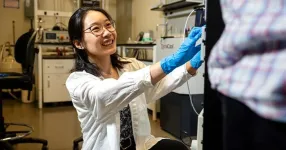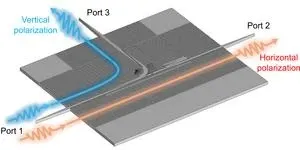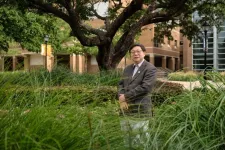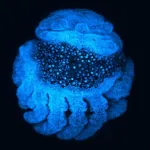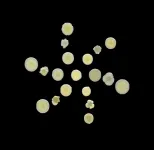(Press-News.org) This summer, Yishu Wang was awarded a $719,000 research grant from the United States Department of Energy (DOE) to study the dynamic and microscopic behaviors of magnets with quantum mechanical properties.
Magnetism originates from electrons in a material. When the electrons in a material all spin in the same direction, as they do in metals like iron, the material is magnetic, with poles that attract or repel other magnetic materials.
“Magnets that we are using today can be viewed as static orderings of electrons, analogous to the static pattern of brushstrokes in a painting,” said Wang, a joint assistant professor in the Department of Materials Science and Engineering and the Department of Physics and Astronomy. “However, I and other researchers are investigating correlated magnets, which are defined by the vivid, coherent, and entangled dynamics of their electrons’ spins. These magnets can’t be understood from static patterns; they are more like movies than paintings.”
The electrons in correlated magnets exhibit quantum mechanical interactions, leading to unconventional superconductivity, quantum entanglement, and other novel features. That gives correlated magnets strong potential in energy-efficient devices capable of high-speed computation, among other applications.
Adding Time Resolution to Neutron Scattering
Conventional neutron scattering—the typical method of investigating materials at the atomic scale—reveals limited snapshots of the electrons’ spin-spin correlations but does not adequately capture the properties of novel magnets that lack a static ordering.
Over the next three years, Wang will use her DOE funding to develop a new capability of neutron scattering that will fully capture the spin dynamics in correlated magnets over time.
The preliminary data used in her grant proposal was analyzed by UT undergraduate computer science students.
“Working with undergraduate students from diverse academic backgrounds has been one of my greatest joys since becoming a faculty member at UT,” Wang said. “Thanks to their work and this funding, we will be able to capture the dynamic behaviors of correlated magnetic systems with a refreshed perspective, gaining deeper insights into their underlying quantum mechanical interactions.”
Throughout the grant, Wang will collaborate with colleagues at both UT and the Neutron Science Division at Oak Ridge National Laboratory (ORNL) who will help her synthesize correlated magnetic materials to investigate, develop and implement instrumentation to perform experiments, and interpret the experimental data.
The instruments and methods that Wang develops will remain available in ORNL’s Spallation Neutron Source (SNS) for future studies.
“This research is particularly valuable to the quantum science community,” Wang said, “but the development of neutron scattering with time resolution will benefit a range of scientific communities and help secure the SNS as the world’s premier innovation center for neutron science.”
END
Wang investigates dynamic electron spins in correlated magnets
2024-08-29
ELSE PRESS RELEASES FROM THIS DATE:
Silicon chip propels 6G communications forward
2024-08-29
Terahertz communications represent the next frontier in wireless technology, promising data transmission rates far exceeding current systems.
By operating at terahertz frequencies, these systems can support unprecedented bandwidth, enabling ultra-fast wireless communication and data transfer. However, one of the significant challenges in terahertz communications is effectively managing and utilising the available spectrum.
The team has developed the first integrated terahertz polarisation (de)multiplexer implemented on a substrateless silicon base which they have successfully tested in the sub-terahertz J-band (220-330 GHz) for 6G communications and beyond.
The University of Adelaide’s ...
Community college students conduct research at UTA
2024-08-29
Studies have shown that undergraduate students who participate in research activities under the guidance of a faculty mentor are more likely to finish college. That’s one of the many reasons universities like The University of Texas at Arlington are increasing their investment into undergraduate research.
Such research opportunities are not offered at many two-year colleges. To help bridge this gap, Jianzhong Su, professor of mathematics at UTA, is piloting a new program where students from the North Lake campus of Dallas College can come to UT Arlington to participate in a paid research ...
VENUS rising: A new dawn for AI-powered atomic-scale 3D imaging
2024-08-29
The Department of Energy’s Oak Ridge National Laboratory added a new neutron scattering instrument to its powerhouse of discovery at the Spallation Neutron Source, charting new territory for neutron imaging through artificial intelligence. In July, DOE’s Office of Science approved the final commissioning of the Versatile Neutron Imaging Instrument, or VENUS.
“It’s a dream come true,” said ORNL neutron scattering scientist Hassina Bilheux. “It has been an honor and privilege to ...
Machine learning helps identify rheumatoid arthritis subtypes
2024-08-29
A machine-learning tool created by Weill Cornell Medicine and Hospital for Special Surgery (HSS) investigators can help distinguish subtypes of rheumatoid arthritis (RA), which may help scientists find ways to improve care for the complex condition.
The study published Aug. 29 in Nature Communications shows that artificial intelligence and machine learning technologies can effectively and efficiently subtype pathology samples from patients with RA.
“Our tool automates the analysis of pathology slides, which may one day lead to more precise and efficient disease diagnosis and personalized treatment for ...
Ancient gene gives spiders their narrow waist
2024-08-29
An ancient gene is crucial for the development of the distinctive waist that divides the spider body plan in two, according to a study publishing August 29th in the open-access journal PLOS Biology by Emily Setton from the University of Wisconsin-Madison, US, and colleagues.
The spider body is divided into two sections, separated by a narrow waist. Compared to insects and crustaceans, relatively little is known about embryonic development in spiders, and the genes involved in the formation of the spider waist are poorly understood.
To investigate, researchers sequenced genes expressed in embryos of the Texas brown tarantula (Aphonopelma hentzi) ...
How a salt giant radically reshaped Mediterranean marine biodiversity
2024-08-29
A new study paves the way to understanding biotic recovery after an ecological crisis in the Mediterranean Sea about 5.5 million years ago. An international team led by Konstantina Agiadi from the University of Vienna has now been able to quantify how marine biota was impacted by the salinization of the Mediterranean: Only 11 percent of the endemic species survived the crisis, and the biodiversity did not recover for at least another 1.7 million years. The study was just published in the renowned journal Science.
Lithospheric movements throughout Earth history have repeatedly led to the isolation of regional seas from the ...
Bacteria able to overcome cost of vancomycin resistance in lab setting
2024-08-29
Staphylococcus aureus has the potential to develop durable vancomycin resistance, according to a study published August 28, 2024, in the open-access journal PLOS Pathogens by Samuel Blechman and Erik Wright from the University of Pittsburgh, USA.
Despite decades of widespread treatment with the antibiotic vancomycin, vancomycin resistance among the bacterium S. aureus is extremely uncommon—only 16 such cases have reported in the U.S. to date. Vancomycin resistance mutations enable bacteria to grow in the presence of vancomycin, but they do so at a cost. Vancomycin-resistant S. aureus (VRSA) strains grow more slowly and will often lose their resistance mutations if vancomycin ...
Wearable “smart mask” monitors disease by capturing and analyzing exhaled breaths
2024-08-29
A person’s exhaled breath – which provides information that could unveil diverse health insights – has been hard to analyze. Now, a novel “smart mask” provides real-time, non-invasive monitoring of what people exhale. The mask, dubbed EBCare, captures and analyzes exhaled breath condensate (EBC), and it offers a promising solution for continuous EBC analysis at an affordable cost. “The significance of EBCare lies in its role as a versatile, convenient, efficient, real-time research platform and solution in various medical domains, ...
Cultural traditions, not genetics or environment, inform nest architecture among white-browed sparrow weaver birds
2024-08-29
Challenging long-held beliefs that bird nest building is solely influenced by genetics or the environment, researchers report that the white-browed sparrow weavers of the Kalahari Desert, Africa, build nests with distinct architectural styles that reflect group-specific cultural traditions. “Behavioral traditions in birds have been well documented for song, migration, foraging, and tool use. Here, we add building behavior and show that architectural styles emerge from birds that build together,” write the ...
Oxidative damage riggers micronuclear collapse mechanisms in cancer, two studies report
2024-08-29
Reactive oxygen species (ROS) from mitochondria are key drivers of genetic chaos in cancer by causing the collapse of micronuclear envelopes, a process that fuels the chromosomal instability (CIN) often observed in aggressive tumor behavior. These are the findings of two new studies. The findings identify key proteins in this destructive process – p62 and CHMP7 – revealing potential prognostic markers and therapeutic targets for high-CIN tumors. Errors in chromosome segregation during cell division can lead to chromosomal instability, a key feature of cancer. These errors result in the formation of micronuclei, which are small structures ...
